Abstract
Snow has an important impact on forest ecosystems in mountainous areas. In this study, we developed 14 tree-ring-width chronologies of Schrenk spruce (Picea schrenkiana Fisch. et Mey.) for the Ili-Balkhash Basin (IBB), Central Asia. We analyzed the response of radial growth to temperature, precipitation and snow parameters. The results show that previous winter and current summer precipitation have an important influence on the radial growth of P. schrenkiana. Further, we find spatially inhomogeneous effects of snow on subsequent growing-season tree growth in IBB. The radial growth response of P. schrenkiana to snow shows a weak–strong–weak trend from west to east across the Ili-Balkhash Basin. This spatial difference is mainly related to precipitation, as snow has little effect on tree growth in regions that receive more precipitation. Thus, winter snow has an important influence on the radial growth of trees in regions that receive limited amounts of precipitation.
1. Introduction
The cryosphere has a highly sensitive and important feedback effect on climate. As the most active component of the cryosphere, snow plays an important role in climate variability. Global climate change has profound impacts on temperate and boreal forest ecosystems, particularly due to its influence on snow. Studies consistently report that pre-growing season hydrothermal conditions are crucial for tree growth during the subsequent growing season in water-limited regions [1,2]. Pre- and early growing-season soil water availability is strongly affected by the melting rate and amount of winter snow [3]. Zhang et al. [4] showed that vegetation growth during the growing season in water-limited regions is strongly coupled to both winter snow accumulation and the timing of snowmelt using remote sensing retrievals and a few in situ observations. The ecological importance of winter snow for tree growth has been demonstrated in both boreal and temperate forests [5,6,7]. However, studies regarding the response of forest dynamics to snow are lacking, particularly in arid Central Asia (ACA).
Mountain precipitation and melted snow/ice are important sources of water in ACA. One of the largest basins in the arid region of inland Asia, the Ili-Balkhash Basin (IBB), receives most of its water resources from orographic rain and ice/snow meltwater from the mountains. Because of its aridity and correspondingly fragile ecological environment, the IBB has a special status in global climate change research. Schrenk spruce (Picea schrenkiana Fisch. et Mey.) is a natural dominant and constructive species of the Tianshan Mountains in ACA and plays a vital role in local ecosystems. For this reason, it is of particular importance to assess the growth response of this species to the climate in the context of global climate change [8]. Previous studies have shown that pre- and early growing-season precipitation has an important influence on the radial growth of P. schrenkiana [9,10,11,12,13]. Most of the precipitation that occurs during the pre- and early growing season is stored in the form of ice and snow in the Tianshan Mountains of ACA.
In this study, we analyze the influence of snow on the radial growth of P. schrenkiana by developing 14 tree-ring-width chronologies across the IBB from west to east. We address the following questions using tree-ring chronologies and meteorological station data from an area spanning 1000 km from east to west: 1. How does winter snow affect the radial growth of P. schrenkiana in ACA? 2. Are there spatial differences in tree growth-snow responses; if so, what drives these differences?
2. Materials and Methods
2.1. Study Area
The study area is located in the arid inland area of Central Asia (Figure 1). The upper reaches of the Ili River are composed of three rivers originating in Xinjiang, China. The Turks River flows from the northern slope of the Khan Tengri Peak and into the Gongnais River, which then merges with the Kash River to form the Ili River, then flows into Balkhash Lake in Kazakhstan. The Ili River is also fed by the Charyn, Keskelen, Talgar, Turgen and Chilik Rivers, which drain the Zailiyskiy Alatau Range of the Tianshan Mountains in Kazakhstan. The Ili River is 1439 km long and has a catchment area of 140,000 km2, with a mean annual discharge of about 480 m3/s [14]. The IBB spans China, Kyrgyzstan and Kazakhstan.
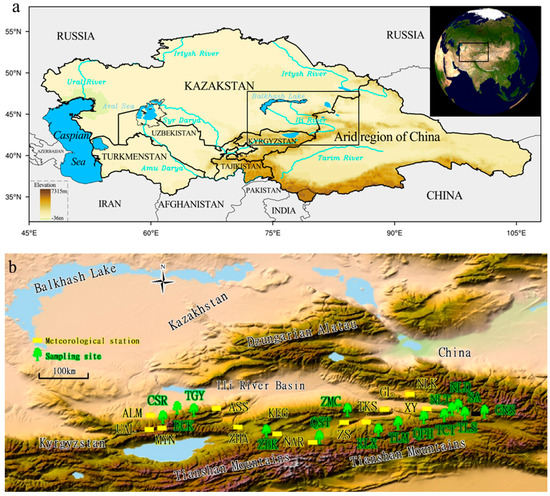
Figure 1.
Locations of study area and sampling sites. (a) Map of arid Central Asia; (b) locations of meteorological stations and sampling sites.
Most rivers in the IBB have headwaters in the Tianshan Mountains. There is a pure forest of P. schrenkiana distributed across the middle mountain zone of the Tianshan Mountains. P. schrenkiana, as an evergreen tree, is a unique Relic Species in Tertiary Forest Plants of central Asia. This tree species likes humid environments and is generally distributed on the shady slopes of sub-alpine mountains at an elevation of 1200–3500 m. Simultaneously, P. schrenkiana forest is a shallow-rooted tree species, the root system is usually distributed in the 40–60 cm soil laye, and it is more sensitive to the external environment. It is the most important zonal forest vegetation, and it is the main body of the forest ecosystem of the Tianshan Mountains. The life span of this tree species is generally 200–300 years, and a single tree can reach more than 400 years. It is one of the ideal tree species for dendroclimatology study. From 2015 to 2017, we collected tree-ring samples of P. schrenkiana from the northern slope of the Tianshan Mountains in China and Kazakhstan. We developed a network of 4 sites in the Zailiyskiy Alatau Range and 10 sites along the upper Ili River. The 14 sampling sites cover the entire IBB and span near 1000 km from west to east on the northern slope of the Tianshan Mountains. Specific sampling sites information is provided in Table 1.

Table 1.
Basic information for each of the sampling sites.
2.2. Method of Establishing Tree-Ring Chronologies
The cores of P. schrenkiana were sampled and pretreated according to the standards of dendroclimatology study [15]. All samples were allowed to dry naturally, then fixed to wooden mounts, and polished using 200 to 1000 grids sandpaper sequentially. The samples were visually inspected and preliminary dating under a microscope, and then the tree-ring widths were measured using a Velmex system (Velmex Inc., Bloomfield, NY, USA), which has an accuracy of 0.001 mm. All cores from each sample site were cross-dated using the line chart comparison method and COFECHA [16]. All samples were detrended and standardized to ring-width indices using ARSTAN in order to clean the time series from non-climate signals in the tree ring time series [17]. We removed the physiological trend of tree growth with a smoothing spline (with a fixed 67% cutoff) [18,19]. Finally, we established 14 tree-ring standardized chronologies according to the above process.
2.3. Meteorological Data
The data from the seven meteorological stations in southeastern Kazakhstan come from RSE “Kazhydromet” (Kazakhstan Hydrometeorological Service). The meteorological data of Gongliu, Xinyuan, Tekesi, Nileke and Zhaosu stations in upper Ili River were obtained from the China Meteorological Data Sharing Service System (http://cdc.cma.gov.cn/ (accessed on 12 May 2017). These stations extend about 1000 km from west to east and encompass plains and mountains, covering a gradient spanning 800–3000 m a.s.l. Detailed information regarding these stations is provided in Table 2. In addition, snow data are available for Kazakhstan and cover the period 1970/1971–2011/2012. Temperature, precipitation and maximum snow depth data from snow avalanche stations were obtained from the Chinese Academy of Sciences. Because these data are discontinuous and have limited time coverage, we only used them for climate background analysis and discussion. Table 3 shows the basic climate information of the annual and critical growing season for all meteorological stations.

Table 2.
Basic information about the meteorological stations.

Table 3.
The basic climate information of the annual and critical growing season for all meteorological stations.
3. Results
3.1. Relationship between the Radial Growth of P. schrenkiana and Climate
Correlation analysis between the tree-ring chronologies and the main climate factors show that the radial growth of P. schrenkiana is significantly positively correlated with previous winter and current summer precipitation in the Tianshan Mountains of southeastern Kazakhstan (Figure 2). The ZBK tree-ring-width chronology has a significant positive correlation with the winter precipitation at all meteorological stations. In particular, the correlation with precipitation in March exceeded the significance test of 99% at all stations (Figure 2). The correlation coefficient between the ZBK chronology and March precipitation at the Zhalanash meteorological station reaches 0.562 (p < 0.01, n = 38) because the sites are spatially proximate (Figure 1). The TGY and ECK chronologies also correlate well with winter precipitation. However, the CSR chronology located in the westernmost region correlates poorly with the precipitation at all meteorological stations. On the whole, the radial growth of P. schrenkiana was affected by the combined effects of precipitation in the previous winter and the current growing season in southeastern Kazakhstan.
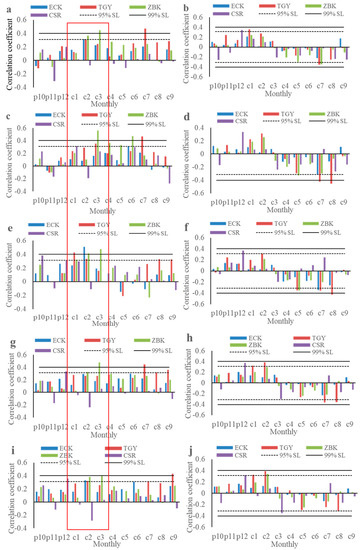
Figure 2.
Correlation coefficients between the radial growth of trees and climate parameters in Kazakhstan (1977–2015). (a) Monthly precipitation at Almaty station; (b) monthly temperature at Almaty station; (c) monthly precipitation at Zhalanash station; (d) monthly temperature at Zhalanash station; (e) monthly precipitation at Assy station; (f) monthly temperature at Assy station; (g) monthly precipitation at Ulken Almaty Lake station; (h) monthly temperature at Ulken Almaty lake station; (i) monthly precipitation at Mynzhylky station; (j) monthly temperature at Mynzhylky station. p10–p12 represents October–December of the previous year, c1–c9 represents January–September of the current year, respectively. The red box indicates the month in which the radial growth of trees is related to precipitation. 99% Significance level (SL) represents passing the 99% significance test, 95% SL represents passing the 95% significance test.
There are significant negative correlations between the radial growth of P. schrenkiana and mean temperature during the growing season in the Tianshan Mountains of southeastern Kazakhstan (Figure 2). Radial growth is also significantly positively correlated with the previous winter temperature. The tree-ring chronologies at low and middle elevations (ZBK, TGY and ECK) are significantly negatively correlated with summer temperature. The correlation coefficient between the TGY chronology and August temperature at the Zhalanash meteorological station reaches −0.454 (p < 0.01, n = 38) (Figure 2). The radial growth of P. schrenkiana located in the westernmost (CSR) region is not significantly correlated with summer temperature but is significantly positively correlated with the winter temperature of the previous year.
Correlation analysis between the tree-ring chronologies and key climate factors show that the radial growth of P. schrenkiana is also significantly positively correlated with previous winter and current summer precipitation in the upper Ili River basin, China (Figure 3). The KLX tree-ring-width chronology is significantly positively correlated with pre-growing season climate variables at all meteorological stations. In particular, correlations with precipitation in April exceed the significance test of 99% for all stations. The correlation coefficient between the KLX chronology and April precipitation at the Zhaosu meteorological station reaches 0.447 (p < 0.01, n = 54) because the two sites have very similar elevations (Figure 1). The TLM, QST and TCT chronologies also correlate well with pre-growing season precipitation. The correlation coefficient between the QST chronology and April precipitation at the Zhaosu meteorological station reaches 0.46 (p < 0.01, n = 54) because the two sites are spatially proximate (Figure 1). All chronologies are also well correlated with summer precipitation. The QST chronology and July precipitation at the Tekesi meteorological station have a correlation of 0.487 (p < 0.01, n = 54) (Figure 3). Overall, the radial growth of P. schrenkiana at lower elevations is affected by pre-growing season precipitation. There are significant negative correlations between the radial growth of P. schrenkiana and spring mean temperature in the upper Ili River basin, China. The NLD chronology has a significant negative correlation with May temperature at all meteorological stations (Figure 3).
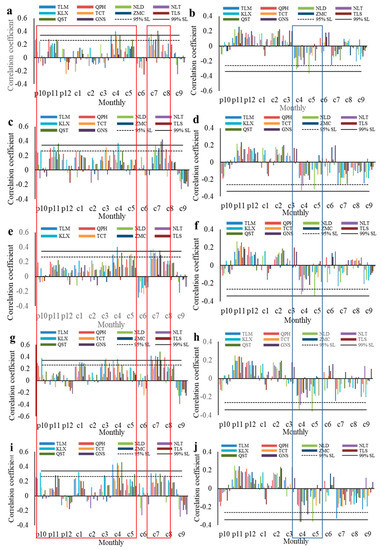
Figure 3.
Correlation coefficients between the radial growth of trees and climate parameters along the Upper Ili River, China (1960–2014). (a) Monthly precipitation at Gongliu station; (b) monthly temperature at Gongliu station; (c) monthly precipitation at Xinyuan station; (d) monthly temperature at Xinyuan station; (e) monthly precipitation at Nileke station; (f) monthly temperature at Nileke station; (g) monthly precipitation at Tekesi station; (h) monthly temperature at Tekesi station; (i) monthly precipitation at Zhaosu station; (j) monthly temperature at Zhaosu station. The red box indicates the month in which the radial growth of trees is related to precipitation. The blue box represents the months in which the radial growth of trees is significantly correlated with temperature.
3.2. Tree Growth–Snow Relationship
The tree-ring-width chronologies of southeastern Kazakhstan and China’s Ili region are significantly correlated with pre-growing season precipitation, which occurs mostly in the form of snow. For this reason, we further analyzed the relationship between the radial growth of P. schrenkiana and snow parameters. We analyzed the correlation between the snowfall from the previous November to the current April, winter snowfall, maximum snow depth, snow water equivalent of the meteorological stations and four tree-ring width chronologies in southeastern Kazakhstan. The results show that all snow parameters are significantly positively correlated with the ECK, TGY, and ZBK tree-ring-width chronologies. In particular, the easternmost ZBK chronology has the best correlation with all snow parameters (Figure 4). For example, the correlation coefficient between snowfall from the previous November to the current April at Assy station and the ZBK chronology is as high as 0.577 (p < 0.01, n = 38) (Figure 4). However, the CSR chronology in the westernmost region has a weak correlation with snow parameters at all stations. Overall, the correlation coefficients between the chronologies and snow are higher in eastern Kazakhstan than in western Kazakhstan (Figure 4).
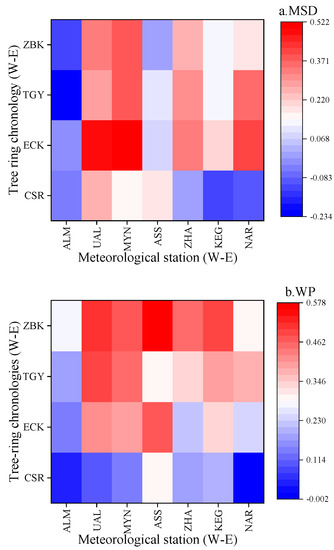
Figure 4.
(a) Heat map of the correlations between the maximum snow depth and tree ring width in Kazakhstan (from west to east); (b) heat map of the correlations between the precipitation from previous November to current April and tree ring width in Kazakhstan (from west to east). MSD and WP represent maximum snow depth and winter snowfall, respectively.
Correlation analysis between the 10 tree-ring-width chronologies and snow parameters (snowfall from the previous November to the current April, winter snowfall, maximum snow depth) from five meteorological stations in the upper Ili River basin of China show strong spatial inhomogeneity. The west tree-ring chronology is significantly positively correlated with all snow parameters (Figure 5). For example, the QST chronology in the west has a significant positive correlation with the snow parameters at all of the meteorological stations. The correlation coefficient between the QST chronology and snowfall from the previous November to the current April at the Zhaosu meteorological station is as high as 0.477 (p < 0.01, n = 55) (Figure 5). In contrast, the four chronologies (GNS, TLS, NLD and NLT) in the east have the weakest correlation with all snow parameters (Figure 5). In other words, there is a stronger correlation between snow and tree growth in the west than there is in the east over the upper Ili River basin.
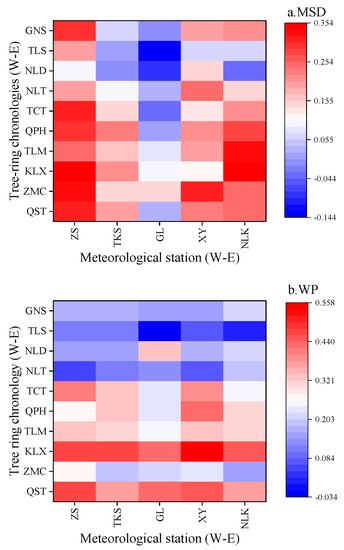
Figure 5.
(a) Heat map of the correlations between maximum snow depth and tree-ring width in the upper Ili River basin (from west to east); (b) heat map of the correlations between precipitation from previous November to current April and tree-ring width in the upper Ili River basin (from west to east). MSD and WP represent maximum snow depth and winter snowfall, respectively.
If we regard southeastern Kazakhstan and the upper Ili River basin as a whole, we find that the radial growth of P. schrenkiana shows a weak–strong–weak trend in response to snow from the west (Almaty) to the east (Gongnais). Hence, snow has a spatially inhomogeneous influence on tree growth across the IBB.
4. Discussion
Our analysis shows that the radial growth of P. schrenkiana is significantly positively correlated with previous winter snow/precipitation in the IBB. Fritts [15] suggested that climatic conditions in autumn, winter and spring prior to the growing season might affect ring-width growth during the growing period. Many subsequent studies have shown that the radial growth of P. schrenkiana is affected by precipitation before and during the growing season [9,10,11,12,13]. The significant negative correlation between the low elevation NLD chronology and spring temperature in the Ili River basin is likely the result of temperature-induced drought at low elevation in spring, which is not conducive to the radial growth of P. schrenkiana. Because late spring and early summer is the period of rapid growth for P. schrenkiana, spring drought has a decisive influence on the radial growth [13]. Zhang et al. [11] suggested that spring drought is the main factor limiting the radial growth of trees in Ili River basin, China.
Winter snow is an important driver of subsequent tree growth due to its regulating effect on a range of ecosystem processes. These processes include an increase in soil moisture content, which could partially compensate for water loss caused by drought during the growing season [20,21], the insulation effects of snow, which reduce winter damage to the shallow roots of trees [6,22,23,24,25,26] and the regulation of soil nutrient cycles [27]. The discovery that radial growth response to snow shows a weak–strong–weak trend from west to east across the IBB is physiologically explainable. The western IBB is one of the wettest areas in the Tianshan Mountains; the total annual precipitation recorded at both the MYN and UAL stations in this mountainous area exceeds 800 mm. Even the Almaty station located in the plain region shows total annual precipitation of more than 600 mm (Table 3). The eastern end of the Ili River basin is also relatively wet. The snow and avalanche station in this area also records total annual precipitation exceeding 800 mm. Winter snow has no obvious effect on tree growth in these areas because precipitation during the growing season is sufficient for tree growth.
In contrast, records from stations located between these two precipitation centers show annual precipitation totals of only 300–500 mm (Table 3), an amount that has a more limiting effect on tree growth. Zhang et al. [13] showed that the period of rapid growth of P. schrenkiana is from May to June. However, precipitation at most stations during this period barely exceeds 150 mm (Table 3). This is insufficient for rapid growth in the late spring and early summer, especially following spring drought. Thus, winter snow can play a key role in tree growth in these drier middle regions.
Snow may affect tree growth in several ways. First, thicker snow can extend the snowmelt period in spring to ensure sufficient water for early wood growth and the formation of wider annual rings. Second, thicker snow can increase soil water content to compensate for the lack of water caused by spring drought in arid areas, which otherwise inhibit the growth of cambium tracheids and the speed of cell division [15,28]. Third, thicker snow helps maintain a more constant soil temperature, resulting in the extension of the growth period and reducing root damage [29]. Many previous studies have shown that heavy snowfall in the non-growing season is beneficial to the water absorption of trees in the early stages of the growing season and results in the formation of a wide ring [30,31]. Vaganov et al. [32] showed that winter precipitation (snow) is significantly positively correlated with the radial growth trend of trees. Vicente-Serrano et al. [33] suggested that forests in water-limited temperate regions respond to relatively longer drought timescales, which implies a strong carryover effect of preceding drought stress on subsequent tree growth. Wu et al. [27] suggested that snow is an important driver of tree growth in regions where growing-season precipitation is limited. Li et al. [34] also found that winter snow plays a crucial role in regulating tree growth during the subsequent growing season in regions that experience seasonal or even annual drought stress. These studies and our results show that winter snow has an important impact on the radial growth of trees in precipitation-limited regions.
5. Conclusions
Regional climate change has an important impact on forest ecosystems, particularly through its influence on factors that directly affect tree growth, such as snow. However, different site conditions in mountainous areas lead to different levels of impact. In this study, we developed a network of 4 tree-ring sites in Kazakhstan and 10 sites in China. Our tree-ring chronologies and meteorological data span about 1000 km from west to east. Using these data, we explored the relationship between snow and the radial growth of trees in a typical watershed in arid Central Asia. The results show that the radial growth of P. schrenkiana is significantly positively correlated with previous winter and current summer precipitation. There are significant negatively correlation between the radial growth of P. schrenkiana and spring mean temperature in the Ili River basin, China, and between radial growth and summer temperature in eastern Kazakhstan. Snow has an important influence on the radial growth of P. schrenkiana. Snow does not contribute significantly to the radial growth of trees in areas with abundant precipitation, but it has an important impact in water-deficient areas. In general, snow is not an absolute limiting factor for the radial growth of trees; to be able to reconstruct past snow changes in the future, it will be necessary to identify other tree-ring parameters that more fully reflect the influence of snow.
Author Contributions
Conceptualization, R.Z. and Y.Y.; data curation, L.Q., R.Z. and K.B.; formal analysis, L.Q.; funding acquisition, L.Q. and R.Z.; investigation, H.S., R.Z., S.Y., K.B., T.Z., A.B. and M.B.; methodology, L.Q.; resources, R.Z. and K.B.; validation, L.Q.; writing—original draft, L.Q. and R.Z.; writing—review and editing, L.Q. and R.Z. All authors have read and agreed to the published version of the manuscript.
Funding
This work was supported by the National Natural Science Foundation of China Projects (41805130, 41975110), the Key Laboratory Opening Foundation of Xinjiang Uigur Autonomous Region (2019D04002), the Regional collaborative innovation project of Xinjiang Uygur Autonomous Region (2021E01022), the Tianshan Youth Project of Xinjiang Uigur Autonomous Region (2020Q026) and the Tianshan Cedar Project of Xinjiang Uigur Autonomous Region (2019XS12).
Data Availability Statement
The data presented in this study are available on request from the corresponding author.
Conflicts of Interest
The authors declare that they have no conflict of interest.
References
- Wu, X.; Liu, H.; Guo, D.; Anenkhonov, O.A.; Badmaeva, N.K.; Sandanov, D.V. Growth Decline Linked to Warming-Induced Water Limitation in Hemi-Boreal Forests. PLoS ONE 2012, 7, e42619. [Google Scholar] [CrossRef] [Green Version]
- Liu, H.; Williams, A.P.; Allen, C.D.; Guo, D.; Wu, X.; Anenkhonov, O.A.; Liang, E.; Sandanov, D.V.; Yin, Y.; Qi, Z.; et al. Rapid warming accelerates tree growth decline in semi-arid forests of Inner Asia. Glob. Chang. Biol. 2013, 19, 2500–2510. [Google Scholar] [CrossRef] [PubMed]
- Guo, W.; Liu, H.; Anenkhonov, O.A.; Shangguan, H.; Sandanov, D.V.; Korolyuk, A.Y.; Hu, G.; Wu, X. Vegetation can strongly regulate permafrost degradation at its southern edge through changing surface freeze-thaw processes. Agric. For. Meteorol. 2018, 252, 10–17. [Google Scholar] [CrossRef]
- Zhang, R.; Ouyang, Z.-T.; Xie, X.; Guo, H.-Q.; Tan, D.-Y.; Xiao, X.-M.; Qi, J.-G.; Zhao, B. Impact of Climate Change on Vegetation Growth in Arid Northwest of China from 1982 to 2011. Remote Sens. 2016, 8, 364. [Google Scholar] [CrossRef] [Green Version]
- Hu, J.; Moore, D.J.P.; Burns, S.P.; Monson, R.K. Longer growing seasons lead to less carbon sequestration by a subalpine forest. Glob. Chang. Biol. 2010, 16, 771–783. [Google Scholar] [CrossRef]
- Blume-Werry, G.; Kreyling, J.; Laudon, H.; Milbau, A. Short-term climate change manipulation effects do not scale up to long-term legacies: Effects of an absent snow cover on boreal forest plants. J. Ecol. 2016, 104, 1638–1648. [Google Scholar] [CrossRef]
- Christiansen, C.T.; Lafreniére, M.J.; Henry, G.H.R.; Grogan, P. Long-term deepened snow promotes tundra evergreen shrub growth and summertime ecosystem net CO2 gain but reduces soil carbon and nutrient pools. Glob. Chang. Biol. 2018, 24, 3508–3525. [Google Scholar] [CrossRef]
- Huo, Y.; Gou, X.; Liu, W.; Li, J.; Zhang, F.; Fang, K. Climate–growth relationships of Schrenk spruce (Picea schrenkiana) along an altitudinal gradient in the western Tianshan mountains, northwest China. Trees 2017, 31, 429–439. [Google Scholar] [CrossRef] [Green Version]
- Yuan, Y.; Jin, L.; Shao, X.; He, Q.; Li, Z.; Li, J. Variations of the spring precipitation day numbers reconstructed from tree rings in the Urumqi River drainage, Tianshan Mts. over the last 370 years. Chin. Sci. Bull. 2003, 48, 1507–1510. [Google Scholar] [CrossRef]
- Yuan, Y.; Li, J.; Zhang, J. 348 year precipitation reconstruction from tree-rings for the North Slope of the middle Tianshan Mountains. Acta Meteorol. Sin. 2001, 15, 95–104. Available online: http://www.cqvip.com/qk/88418x/200101/1001466102.html (accessed on 12 May 2015).
- Zhang, R.; Shang, H.; Yu, S.; He, Q.; Yuan, Y.; Bolatov, K.; Mambetov, B.T. Tree-ring-based precipitation reconstruction in southern Kazakhstan, reveals drought variability since A.D. 1770. Int. J. Clim. 2016, 37, 741–750. [Google Scholar] [CrossRef]
- Zhang, R.; Yuan, Y.; Gou, X.; He, Q.; Shang, H.; Zhang, T.; Chen, F.; Ermenbaev, B.; Yu, S.; Qin, L.; et al. Tree-ring-based moisture variability in western Tianshan Mountains since A.D. 1882 and its possible driving mechanism. Agric. For. Meteorol. 2016, 218–219, 267–276. [Google Scholar] [CrossRef]
- Zhang, R.; Yuan, Y.; Gou, X.; Zhang, T.; Zou, C.; Ji, C.; Fan, Z.; Qin, L.; Shang, H.; Li, X. Intra-annual radial growth of Schrenk spruce (Picea schrenkiana Fisch. et Mey) and its response to climate on the northern slopes of the Tianshan Mountains. Dendrochronologia 2016, 40, 36–42. [Google Scholar] [CrossRef]
- Panyushkina, I.P.; Meko, D.M.; Macklin, M.G.; Toonen, W.H.J.; Mukhamadiev, N.S.; Konovalov, V.G.; Ashikbaev, N.Z.; Sagitov, A.O. Runoff variations in Lake Balkhash Basin, Central Asia, 1779–2015, inferred from tree rings. Clim. Dyn. 2018, 51, 3161–3177. [Google Scholar] [CrossRef]
- Fritts, H.C. Tree Rings and Climate; Academic Press: New York, NY, USA, 1976. [Google Scholar]
- Holmes, R.L. Computer-assisted quality control in tree-ring dating and measurement. Tree-Ring Bull. 1983, 43, 69–75. Available online: https://repository.arizona.edu/bitstream/handle/10150/261223/trb-43-069-078.pdf (accessed on 12 May 2015).
- Cook, E.R. A Time-Series Analysis Approach to Tree-Ring Standardization. Ph.D. Thesis, University of Arizona, Arizona, AZ, USA, 1985. [Google Scholar]
- Cook, E.R.; Kairiukstis, L.A. Methods of Dendrochronology: Applications in the Environmental Sciences; Kluwer Academic Publishers: Boston, MA, USA, 1990. [Google Scholar]
- Briffa, K.R.; Melvin, T.M. A Closer Look at Regional Curve Standardisation of Tree-Ring Records: Justification of the Need, a Warning of Some Pitfalls, and Suggested Improvements in Its Application. In Dendroclimatology: Developments in Paleoenvironmental Research; Hughes, M.K., Diaz, H.F., Swetnam, T.W., Eds.; Springer: Dordrecht, The Netherlands, 2010; Volume 11, pp. 113–145. [Google Scholar]
- Potopová, V.; Boroneanţ, C.; Možný, M.; Soukup, J. Driving role of snow cover on soil moisture and drought development during the growing season in the Czech Republic. Int. J. Clim. 2015, 36, 3741–3758. [Google Scholar] [CrossRef] [Green Version]
- Shamir, E.; Meko, D.; Touchan, R.; Lepley, K.S.; Campbell, R.; Kaliff, R.N.; Georgakakos, K.P. Snowpack- and soil water content-related hydrologic indices and their association with radial growth of conifers in the Sierra Nevada, California. J. Geophys. Res. Biogeosci. 2019, 125, e2019JG005331. [Google Scholar] [CrossRef]
- Reinmann, A.B.; Templer, P.H. Reduced Winter Snowpack and Greater Soil Frost Reduce Live Root Biomass and Stimulate Radial Growth and Stem Respiration of Red Maple (Acer rubrum) Trees in a Mixed-Hardwood Forest. Ecosystems 2015, 19, 129–141. [Google Scholar] [CrossRef]
- Reinmann, A.B.; Templer, P.H. Increased soil respiration in response to experimentally reduced snow cover and increased soil freezing in a temperate deciduous forest. Biogeochemistry 2018, 140, 359–371. [Google Scholar] [CrossRef]
- Wipf, S.; Rixen, C. A review of snow manipulation experiments in Arctic and alpine tundra ecosystems. Polar Res. 2010, 29, 95–109. [Google Scholar] [CrossRef]
- Wipf, S.; Stoeckli, V.; Bebi, P. Winter climate change in alpine tundra: Plant responses to changes in snow depth and snowmelt timing. Clim. Chang. 2009, 94, 105–121. [Google Scholar] [CrossRef] [Green Version]
- Reinmann, A.B.; Susser, J.R.; DeMaria, E.M.C.; Templer, P.H. Declines in northern forest tree growth following snowpack decline and soil freezing. Glob. Chang. Biol. 2018, 25, 420–430. [Google Scholar] [CrossRef] [PubMed]
- Wu, X.; Li, X.; Liu, H.; Ciais, P.; Li, Y.; Xu, C.; Babst, F.; Guo, W.; Hao, B.; Wang, P.; et al. Uneven winter snow influence on tree growth across temperate China. Glob. Chang. Biol. 2018, 25, 144–154. [Google Scholar] [CrossRef] [Green Version]
- Akkemik, Ü. Tree rings of Cedrus libani at the northern boundary of its natural distribution. IAWA J. 2003, 24, 63–73. Available online: https://brill.com/view/journals/iawa/24/1/article-p63_6.xml?ebody=pdf-49903 (accessed on 12 May 2015). [CrossRef] [Green Version]
- Liang, E.; Liu, X.; Yuan, Y.; Qin, N.; Fang, X.; Huang, L.; Zhu, H.; Wang, L.; Shao, X. The 1920S Drought Recorded by Tree Rings and Historical Documents in the Semi-Arid and Arid Areas of Northern China. Clim. Chang. 2006, 79, 403–432. [Google Scholar] [CrossRef]
- D’Arrigo, R.D.; Jacoby, G.C. A 1000-year record of winter precipitation from northwestern New Mexico, USA: A reconstruction from tree-rings and its relation to El Nino and the Southern Oscillation. Holocene 1991, 1, 95–101. [Google Scholar] [CrossRef]
- Díaz, S.C.; Therrell, M.D.; Stahle, D.W.; Cleaveland, M.K. Chihuahua (Mexico) winter-spring precipitation reconstructed from tree-rings, 1647–1992. Clim. Res. 2002, 22, 237–244. [Google Scholar] [CrossRef] [Green Version]
- Vaganov, E.A.; Hughes, M.K.; Kirdyanov, A.V.; Schweingruber, F.H.; Silkin, P.P. Influence of snowfall and melt timing on tree growth in subarctic Eurasia. Nat. Cell Biol. 1999, 400, 149–151. [Google Scholar] [CrossRef]
- Vicente-Serrano, S.M.; Gouveia, C.; Camarero, J.J.; Beguería, S.; Trigo, R.; Lopez-Moreno, J.I.; Azorin-Molina, C.; Pasho, E.; Lorenzo-Lacruz, J.; Revuelto, J.; et al. Response of vegetation to drought time-scales across global land biomes. Proc. Natl. Acad. Sci. USA 2013, 110, 52–57. [Google Scholar] [CrossRef] [Green Version]
- Li, Y.; Wu, X.; Huang, Y.; Li, X.; Shi, F.; Zhao, S.; Yang, Y.; Tian, Y.; Wang, P.; Zhang, S.; et al. Compensation effect of winter snow on larch growth in Northeast China. Clim. Chang. 2021, 164, 1–17. [Google Scholar] [CrossRef]
Publisher’s Note: MDPI stays neutral with regard to jurisdictional claims in published maps and institutional affiliations. |
© 2022 by the authors. Licensee MDPI, Basel, Switzerland. This article is an open access article distributed under the terms and conditions of the Creative Commons Attribution (CC BY) license (https://creativecommons.org/licenses/by/4.0/).